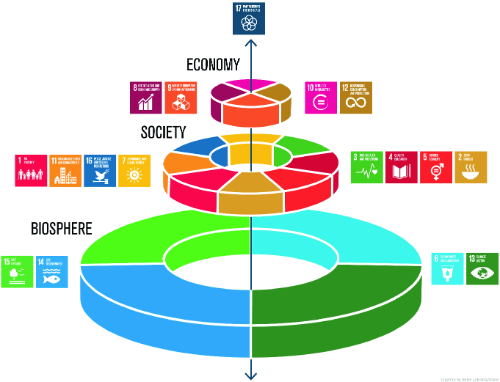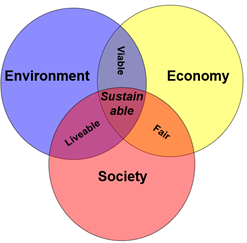About the SDGs
What are the SDGs?
The United Nations Sustainable Development Goals (SDGs) are embedded within the UN’s 2030 Agenda.1 This is an ambitious 15-year strategic vision with a blueprint for peace and prosperity and the partnerships needed for people and the planet (5-Ps) for the present without compromising the ability of future generations to meet their own needs. The UN’s transformative vision calls for a just, equitable, tolerant, open, and socially inclusive world in which the needs of the most vulnerable are met and no one is left behind.
-511x502.png)
Overview of the SDGs
History:
The concept of sustainable development as a balance between environmental conservation and economic growth can be traced back to the 1972 U.N. Conference on the Human Environment in Stockholm. The concept was further refined in the Brundtland Commission report entitled Our Common Future in 1987. A coherent policy framework was not produced by the Brundtland Commission given the impasse between emerging neoliberal ideals among developed nations in the Global North and the needs of the Global South attempting to emerge from poverty. 2,3
The concept of sustainable development gained broader appeal by the 1992 United Nations Conference on Environment and Development via the Rio Declaration (Agenda 21) on Environment. This declaration states that “Human beings are at the centre of concerns for sustainable development. They are entitled to a healthy and productive life in harmony with nature.” However, the Rio Declaration fell short on commitments and actions.4,5
The SDG concept emerged from the Rio+20 Summit in June of 2012 where Columbia and Guatemala proposed a follow-on programme to the Millennium Development Goals (2000 – 2015).6 The SDGs were created over a three-year period involving 83 national surveys engaging over 7 million people.1,6,7
In 2014, Irish UN Ambassador, David Donoghue and the Kenyan Ambassador, Macharia Kamau were named as co-facilitators of the intergovernmental negotiations resulting in the 2030 Agenda. This was unanimously adopted by all 193 member states on 25th September 2015. 8,9
The 2017 UNESCO International Conference on Learning Cities was hosted in Cork and continued to place the international SDG spotlight on best practices locally and within Ireland10.
Attributes of the SDGs
The SDGs provide a globally accepted strategic framework, language, philosophy and plan of action to address the environmental, social and economic dimensions of sustainable development.
It is crucial to recognize the holistic nature of the 17 SDGs and 169 SDG Targets which are considered universal, indivisible and interlinked.
The SDGs represent a paradigm shift in sustainable development from a worldview of rich nations supporting poorer nations towards a view where the actions of all, particularly those in wealthy nations, risk destabilizing critical functions of Earth’s life-support system, e.g., climate and biodiversity loss.
The social dimension of the SDGs aims to eradicate poverty; build peaceful, just and inclusive societies; to protect human rights; promote gender equality; and leave no one behind.
The economic dimension calls to create conditions for sustainable, inclusive, and sustained economic growth, shared prosperity, and decent work for all, and taking into account different levels of national development and capacities.
Education for Sustainable Development (ESD) is a lifelong and life-wide learning journey which highlights the need to authentically replicate real world problems, tasks, and situations to provide learners with a meaningful experience.
Ambassador David Donoghue was Ireland’s Irish Permanent Representative to the United Nations and co-facilitator for three major negotiations relating to sustainable development. Also, Irish head of the Anglo-Irish Secretariat in Belfast during negotiations for the Good Friday Agreement. He currently serves on the Leadership Council for the all-island SDSN Ireland co-hosted by University College Cork and Queen’s University Belfast.
Three Pillars of the SDGs
The environmental, social, and economic dimensions of the SDGs take into consideration that all three dimensions need to be balanced within sustainable development policy.1 The 3-tiered wedding cake representation of the SDGs places the biosphere at the foundation which is the aggregation of all living organisms on the Earth and the physical environment where they dwell, i.e., land, water and atmosphere. The middle tier is composed of the SDGs representing social interactions along with issues of inequality and injustice. SDGs related to the economy represent the production and trading of goods and services and they are supported by the biosphere and society. This model for visualizing the SDGs was initially created in the context of food systems but has gained broad application.11

Image credit Illustration by Azote for Stockholm Resilience Centre, Stockholm University
The environmental, social, and economic dimensions of the SDGs have also been expressed as the triple bottom line and represented as a Venn diagram where sustainability is thought to occur at the intersection of all three dimensions.12 This model of sustainability can be applied to the professional or personal decision process of any individual. However, this model assumes that governmental, corporate, institutional, and personal values and practices place equal emphasis on these three dimensions and overlooks the fuzzy boundary among these.
It should be noted that sustainability and sustainable development are not identical terms. The 1987 Brundtland Commission offered a clear and concise definition: development which meets the needs of the present without compromising the ability of future generations to meet their needs. The SDGs offer an accepted framework or strategy for achieving sustainable development as defined in the Brundtland Report. However, this concept of sustainability is anthropocentric and often values natural ecosystems in terms of the services provided for society. It also assumes that science fully comprehends the multiplicity of interconnections within natural ecosystems. However, sustainability takes a broader and more holistic perspective when based on ecological principles. Further, traditional and indigenous concepts of sustainability recognize inherent rights of nature which has inspired constitutional and other legal protections in Ecuador, Bolivia, New Zealand and India.13

The Venn diagram of the 3 pillars of the SDGs are often referred to as the Triple Bottom Line. Development is considered sustainable when environmental, economic and societal pillars are balanced during planning, decision-making and implementation processes.
The SDGs, Targets, and Indicators
Each of the 17 SDGs contain underlying targets which address specific desired outcomes or means of implementation. The 169 SDG Targets are more focused and tangible than the overarching goal, e.g., Target 3.8 states Achieve universal health coverage, including financial risk protection, access to quality essential health-care services and access to safe, effective, quality, and affordable essential medicines and vaccines for all.
In 2017, the U.N. passed a resolution detailing a global indicator framework which informs the annual progress reports on the SDGs.14 There is a total of 231 Indicators which sit beneath the SDG targets. Indicators are measurable and progress can be tracked over time, e.g., 1.2 Proportion of population with primary reliance on clean fuels and technology. However, there is paucity of data to sufficiently evaluate all SDG indications among all nation states.15 The indicators are also subject to an annual review by the UN Statistical Commission where they can be replaced, revised, or deleted.
Section 7 of the 2030 Agenda6 clearly articulates the transformative vision and transcendental ideals encapsulated in the SDGs:
"We envisage a world free of poverty, hunger, disease and want, where all life can thrive. We envisage a world free of fear and violence. A world with universal literacy. A world with equitable and universal access to quality education at all levels, to health care and social protection, where physical, mental, and social well-being are assured. A world where we reaffirm our commitments regarding the human right to safe drinking water and sanitation and where there is improved hygiene; and where food is sufficient, safe, affordable, and nutritious. A world where human habitats are safe, resilient, and sustainable and where there is universal access to affordable, reliable and sustainable energy."
For a complete list of the individual SDGs with overviews, a full list of their targets and indicators, progress based on reports to the Secretary General, and events, publications and news, visit the Department of Economic and Social Affairs Sustainable Development website.
SDG Resources
- Transforming our world: the 2030 Agenda for Sustainable Development
- Report of the United Nations Conference on the Human Environment, Stockholm, 5-16 June 1972
- Report of the World Commission on Environment and Development: "Our common future" Our common future [Brundtland report] Imprint [New York]: UN, 4 Aug. 1987. Description 374 p.
- Report of the United Nations Conference on Environment and Development. Rio de Janeiro, 3-14 June 1992. A/CONF.151/26 (Vol. I)
- Iris Borowy (2018) Sustainable Development and the United Nations. Routledge Handbook of the History of Sustainability, ed. by Jeremy Caradonna.
- 10 facts about the Sustainable Development Goals, World Economic Forum
- Ireland has played a very unique and central role in the process to agree the Sustainable Development Goals, Irish Aid
- U.N. Department of Economic and Social Affairs Sustainable Development
- UNGA President Appoints Co-Facilitators for Post-2015 Negotiations
- Conference Report: Third International Conference on Learning Cities
- How food connects all the SDGs.
- Elkington, J. (1994) Towards the Sustainable Corporation: Win-Win-Win Business Strategies for Sustainable Development. California Management Review, 36, 90-100.
http://dx.doi.org/10.2307/41165746 - Rights of Nature: A Re-examination (2021). Edited by Daniel P. Corrigan and Markku Oksanen. Series: Routledge Explorations in Environmental Studies. ISBN-10:0367479591
- United Nations General Assembly Resolution, 71/313. Work of the Statistical Commission pertaining to the2030Agenda for Sustainable Development
- The United Nations Sustainable Development Goals Report 2020

